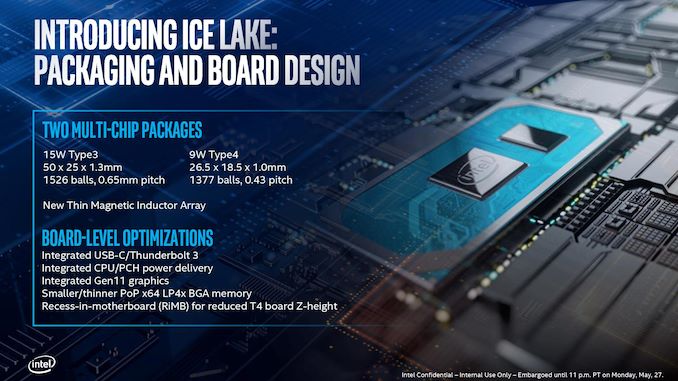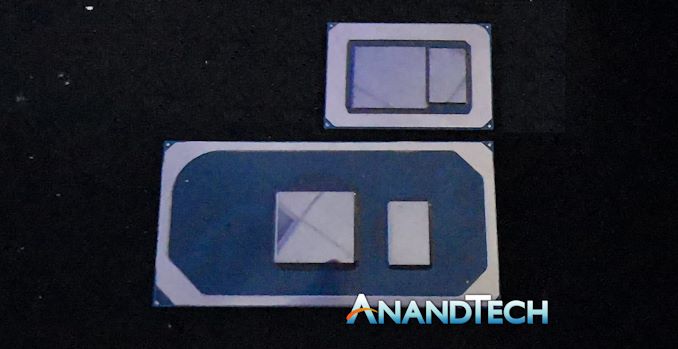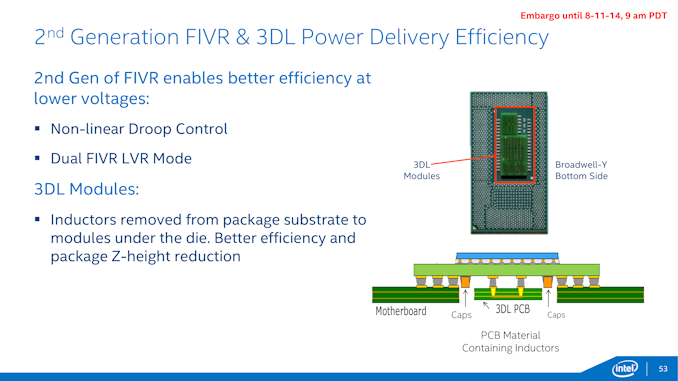Examining Intel's Ice Lake Processors: Taking a Bite of the Sunny Cove Microarchitecture
by Dr. Ian Cutress on July 30, 2019 9:30 AM EST- Posted in
- CPUs
- Intel
- 10nm
- Microarchitecture
- Ice Lake
- Project Athena
- Sunny Cove
- Gen11
Two Versions, Two Different Power Targets
Intel has promised that Ice Lake-U will be seen in a variety of form factors, targeting anywhere from 9W to 28W. This sort of range is not new for a U-series processor – we typically see overlap from something lower down (the Y-series, ~5W) or higher up (H-series, ~45W), however Ice Lake hasn’t currently been listed for H series power budgets - only Y and U. Having such a wide window, from 5-28W, allows Intel to be very wide with binning the chips as they come of the production line, which is a very valid tactic for promoting as much yield as possible with minimal waste.
Technically there will be two different Ice Lake BGA mobile packages – one aimed at low power (7-12W) for the Y series, and another for higher power designs (15-28W) in the U series.
At this point Intel has not stated what core configurations will be in both packages, however it is likely that the lower power 7-12W ‘Type 4’ package will be for Y-series implementations only, especially given that the overall package size is only 490mm2 (26.5x18.5) compared to 1250 mm2 (50x25), making it 39% the size of the larger high power package. It stands to reason then that the smaller package is for lower performance and low power options, despite being exactly the same silicon.
This Type-4 option also uses the ‘recessed in board’ design we first saw with Broadwell-Y, which is required based on the integrated voltage regulators that Intel now uses on its low powered designs. This makes a very interesting point about Intel’s capabilities with low powered 10nm designs: one could postulate that as the recessed model is well above the traditional Y-series power line. If the 10nm process doesn’t go low down enough in power to that sub-5W range, it could either be because of power, or there isn't enough frequency for Intel to actually sell at volume. Alternatively Intel could end up increasing the base power of the Y-series. One could draw parallels with the first generation 10nm Cannon Lake Core i3-8121U at 15W, which was initially postulated to be dual-core Y-series silicon, rather than the 15W U-series designation it ended up with (our review showed that it did indeed consume more power for the same work compared to a 14nm equivalent design, which would imply a very high static power). With this in mind, it makes me wonder what percentage of Type 3 / Type 4 package designs Intel will end up shipping into the market.
Broadwell Motherboard Design for Recessed Power Implementation
Intel is keen to promote that one of the new features of Ice Lake is its Thin Magnetic Inductor Array, which helps the FIVR achieve better power conversion efficiencies and waste less power. The main issue with a FIVR is at low power consumption states that have a lot of inefficiency – some other processor designs have a linear LDO (Low-Dropout Regulator) implementation which is better for low power designs but less efficient in high power modes.













107 Comments
View All Comments
notashill - Tuesday, July 30, 2019 - link
Are those RAM/SSD targets really "greater than" 8GB/256GB or is it supposed to be "greater than or equal to"?Either way I would love to see an end to companies having >$1000 machines with pathetically low RAM/storage and then charging 500%+ markups to upgrade them to something decent. Like Microsoft's $1200 to go from 4/128 to 16/512.
mkozakewich - Wednesday, July 31, 2019 - link
I can't believe Microsoft has been using 4 GB as their base amount for the last six years. At some point it becomes insulting.repoman27 - Tuesday, July 30, 2019 - link
“Intel uses the ‘U’ designation for anything from 9W to 28W TDP, which covers all the mobile ultra-premium devices.”No they don’t. 9W are Y Series, 15 and 28W are U Series. This is all clearly stated in Intel’s publicly available product briefs for 10th Generation Core processors.
HStewart - Tuesday, July 30, 2019 - link
I be curious for more information on the Y processors - what the performance difference between Y and U. But it looks like these Ice Lake chips are designed for Ultraportable machines and not designed to replace to higher end ones - even like my Dell XPS 15 2in1 - I am really curious about that replacement - it's GPU is probably short lived possibly in updated higher voltage Ice Lake with Gen 11 graphics or new version with Xe graphics. I also have a Dell XPS 13 2in1 with Y processor - I am actually bringing it to meeting today - it is lightweight and does not really need that much power for what I using it for. I think it will be very interesting to compare this new XPS 13 2in1 and the existing XPS 15 2in1 - yes 15 2in1 has faster processor - but it not Ice Lake and that could make a huge difference.Hixbot - Tuesday, July 30, 2019 - link
4.2% annual IPC growth doesn't sound great but it is better than anything we've seen since SandyBridge.Targon - Tuesday, July 30, 2019 - link
And that should make people question the claims about performance increases. Mind you, how much performance has been lost on Intel chips due to the security issues? Intel may be comparing theoretical performance increases, without disclosing the fact that first through 9th generation have actually lost performance since launch due to security mitigations.So, +18% IPC, but -20% due to security mitigations for issues that are still there. Has Intel actually fixed the problems with the memory controller and other problems that allow for Meltdown and the other problems, rather than mitigating around the problem? If a problem has existed since first generation Core processors that turns out to be a design flaw, that also shows that the fundamental core design hasn't changed all THAT much.
rahvin - Wednesday, July 31, 2019 - link
Meltdown and some of the first spectre mitigations are going to be fixed in the hardware. Later spectre variants are probably only fixed in microcode and software.Where that line is drawn is going to be determined by when they froze the physical design for tapeout.
eek2121 - Wednesday, July 31, 2019 - link
I'm not knocking Intel on the IPC growth. If they had an 18% increase, great for them! However, mobile Intel CPUs of any variant (U, HK, Y, etc.) are much slower than their desktop counterparts. My Core i7 2600k absolutely destroys the 6700HK in my laptop. Laptops in general are designed to be low power devices, so performance is never the number one factor in designing a laptop, even on the high end. The only exception to this is the so called 'desktop replacements' that weigh a ton, have desktop class hardware, and basically need to be plugged in to not have the battery die after an hour.That's also the reason I take this announcement with a grain of salt. 18% on mobile is one thing. 18% on the desktop is something else. As I've mentioned to people here and elsewhere, the smaller the process, the harder it is to maintain high clock speeds. Also, from reading certain documentation, it seems that part of that 18% is counting the addition of AVX-512. I could be mistaken though.
erple2 - Wednesday, July 31, 2019 - link
Wow, really? That has not been my experience at all. My 6700hq has generally been (usually significantly) better performing than my 2600k for the vast majority of tasks I've thrown at it.jospoortvliet - Monday, August 5, 2019 - link
Any task that requires sustained compute will of course suffer on thr lower power budget on mobile. But tasks which require short bursts of activity will do better thanks to vastly improved turbo since the 2600k. So depending on what you do your impression might very well be accurate.